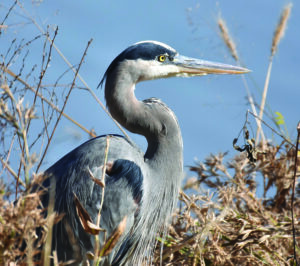(Editor’s note: Suzette Stitely is a member of the Talbot Bird Club and travels extensively for birdwatching.)

An iconic bird of our area Great Blue Herons enjoy our marshes and crabs as much as we do. Standing a bit over 5 feet tall, the Great Blue Heron is hard to miss. (Photo by Suzette Stitely)
Summer time on the Eastern Shore means boats, water and crabs and if you’re on a boat or near the water enjoying crabs chances are you’ll see a Great Blue Heron.
An iconic bird of our area Great Blue Herons enjoy our marshes and crabs as much as we do.
Standing a bit over 5 feet tall, the Great Blue Heron is hard to miss.
They are one of the most widespread wading birds and can be found all across North America.
Great Blue Herons are a lovely gray/blue color with a head that is mostly white with a dark blue stripe running from behind the eyes to the back of the head and a white crown.
They have pale eyes and a large, heavy yellow bill. Their long legs are brownish.
Great Blue Herons have been observed eating many different things, but the majority of their diet is fish.
Its preferred species are killfish, bay anchovies and juvenile menhaden.
They stand in shallow water and patiently wait for a fish to swim by.
The heron will then stab the fish with its dagger bill and swallow it whole.
Great Blue Herons will eat frogs, snakes, turtles, crabs, rodents and even other birds.
Great Blue Herons tend to forage and roost alone or in small loose groups; however, they do nest in colonies which can be as large as hundreds of pairs.
They begin breeding at about 2 years old.
While Great Blue Herons are monogamous, they choose a new mate most years. Nests are made of sticks (carried by the male and arranged by the female), usually placed in a tree and then lined with moss, pine needles or dry grass.
Three to six eggs are laid and both parents incubate them for about a month.
Eggs and nestlings are predated by Bald Eagles, common ravens and American crows.
Once hatched, both parents feed them and the chicks remain in the nest for about seven weeks before their first flight.
They become independent within a few weeks, although their hunting success is low at first.
The Great Blue Heron population seems to be stable however it can be greatly affected by winter storms and hurricanes. Adult birds have few predators and their estimated life span is 23 years.
Learn more about birds, including the Great Blue Heron, by joining the Talbot Bird Club.
Talbot Bird Club offers local birding trips weekly and welcomes anyone who has an interest in birds, whether a novice or experienced ornithologist, and whether you enjoy watching birds at your feeder or traveling throughout the world.
Our members learn from one another and are willing to share their knowledge.
The Talbot Bird Club is part of the Maryland Ornithological Society and also has a Facebook page.



